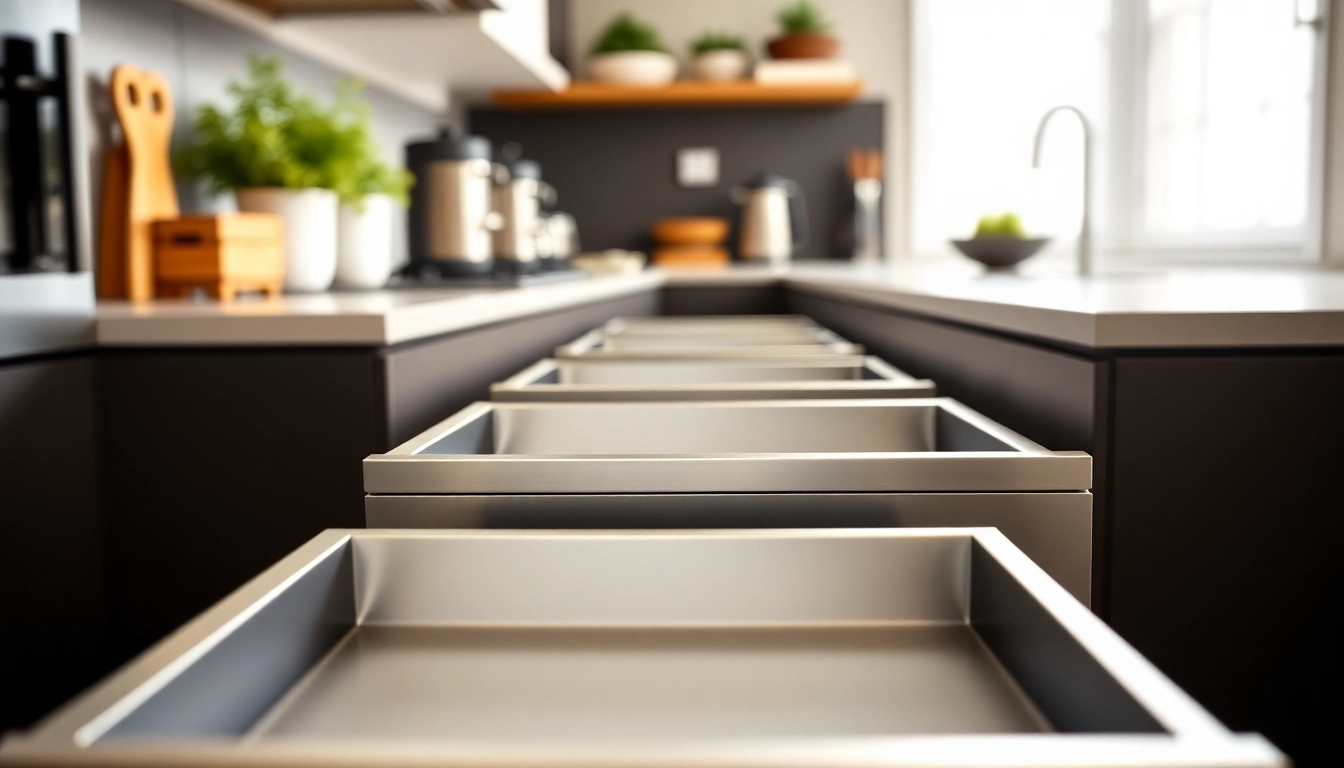Understanding Metal Drawer Systems
What is a Metal Drawer System?
A metal drawer system is an essential component found in various cabinets, furniture, and storage solutions, designed to provide organized and efficient storage. Typically constructed from high-strength steel or aluminum, these systems offer a sturdier alternative to traditional wooden drawers. Their design not only ensures durability and longevity but also facilitates smoother operation with mechanisms such as ball-bearing slides or soft-close features.
Despite their industrial roots, metal drawer systems have found their way into residential and commercial environments alike, blending functionality with sleek aesthetics. From kitchen cabinetry to office furniture, the adaptability of these systems makes them increasingly popular. With an array of customization options available, integrating a metal drawer system into any design is achievable.
Key Components of Metal Drawer Systems
Understanding the key components involved in metal drawer systems can help consumers select the right option for their needs. The primary elements include:
- Drawer Box: The container that holds the items is usually constructed from metal sheets, ensuring strength and resistance to wear.
- Slides: These components are crucial for the operation of the drawer. Ball-bearing slides allow for smooth extension and retraction, while soft-close slides enable silent and gentle closure.
- Mounting Brackets: These parts anchor the drawer system securely to the cabinet structure, providing stability and ensuring that drawers function properly under weight.
Benefits of Using Metal Drawer Systems
Choosing metal drawer systems over traditional materials comes with several advantages:
- Durability: Metal withstands wear and tear better than wood, making it ideal for high-traffic areas or commercial use.
- Safety: Metal systems are less likely to splinter or break, reducing the risk of injury.
- Ease of Maintenance: Unlike wood, which may require varnishing or painting, metal can typically be wiped clean with a damp cloth.
- Design Flexibility: With various finishes and colors available, metal drawers can fit seamlessly into different interior designs.
Types of Metal Drawer Systems
Standard vs. Heavy-Duty Metal Drawer Systems
When selecting a metal drawer system, one must consider the intended use:
- Standard Metal Drawer Systems: These are suitable for home use, such as in kitchen cabinets or bedroom dressers, typically supporting weight capacities of up to 100 pounds.
- Heavy-Duty Metal Drawer Systems: Designed for industrial or commercial applications, these systems are engineered to support heavier loads, often featuring reinforced structures and higher weight capacities, sometimes exceeding 200 pounds.
Drawer Systems with Soft-Close Features
Soft-close drawer systems incorporate advanced mechanics that allow users to push the drawer gently, causing it to close quietly. This feature not only enhances user experience but also prolongs the lifespan of the drawer by reducing wear caused by slamming. This is particularly valuable in environments where noise reduction is necessary, like in open-plan offices or family homes.
Choosing the Right Type for Your Needs
To determine the best metal drawer system, assess the specific requirements:
- Consider weight capacity needed based on what will be stored.
- Evaluate the physical space available, including drawer depth and width.
- Think about the style that best fits your existing decor.
Factors to Consider When Selecting Metal Drawer Systems
Weight Capacity and Durability
Evaluating weight capacity is critical before making a purchase. Metal drawer systems are designed to carry varying loads, and understanding your storage needs will guide you toward the right choice. Durability should also be a focus; look for drawers constructed from quality materials and that feature robust slides capable of handling weight consistently.
Dimensions and Space Considerations
Space constraints often dictate drawer dimensions. Measure the installation area thoroughly—height, width, and depth—before purchasing. Many manufacturers provide standard sizes, but custom options are also available, allowing for a perfectly tailored fit within your furniture or cabinetry. Furthermore, check clearance space to ensure smooth sliding of the drawers.
Design and Aesthetic Matching
Metal drawer systems come in a variety of finishes—from brushed steel to matte black—enabling compatibility with many design schemes. Consider the overall aesthetic of your space when selecting a drawer system, ensuring it contributes positively to the design rather than detracting from it. Integration with other materials, such as wood or laminate, can create a striking effect when done correctly.
Installation Process for Metal Drawer Systems
Tools and Materials Required
Before starting the installation, gather the necessary tools and materials:
- Power drill
- Screwdriver (both flat-head and Phillips)
- Tape measure
- Level
- Wood screws
- Metal drawer system and accompanying hardware
Step-by-Step Installation Guide
Follow these steps for installing a metal drawer system:
- Measure the Space: Start by measuring the area where the drawer will reside.
- Attach Slides to Drawer Box: Follow the manufacturer’s instructions to attach the drawer slides to the sides of the drawer box. Be sure to use a level to ensure proper alignment.
- Install the Mounting Brackets: Secure the mounting brackets in the cabinet, making sure they are aligned with the slides.
- Insert Drawer: Carefully slide the drawer onto the installed slides, ensuring it sits correctly.
- Test Functionality: Open and close the drawer to confirm the mechanism works smoothly.
Common Installation Mistakes to Avoid
Some common pitfalls in the installation process include:
- Improper measurements, leading to a poor fit
- Neglecting to ensure that the slides are level, causing the drawer to hang at an angle
- Failing to use the recommended hardware, which could affect functionality
Maintenance and Troubleshooting for Metal Drawer Systems
Routine Maintenance Tips
To maintain your metal drawer system, consider the following tips:
- Periodically check for loose screws and tighten them as necessary.
- Clean the slides and runners with a damp cloth to remove dust and debris that may impede motion.
- Apply lubricant to the moving parts every six months for optimal performance.
Troubleshooting Common Issues
If your metal drawer system isn’t functioning as expected, troubleshoot the following:
- Drawer Sticking: Check for objects obstructing the rail or debris on the slides.
- Uneven Closing: Confirm that the slides are level and are properly mounted.
- Noisy Operation: Ensure the mechanism is well-lubricated and clean.
When to Seek Professional Help
If issues persist after troubleshooting, it may be wise to consult with a professional installer. This is particularly relevant for heavy-duty installations or when the existing cabinetry requires significant modification. An experienced installer can provide insights into the best practices for your specific unit and ensure that it is set up correctly.























+ There are no comments
Add yours